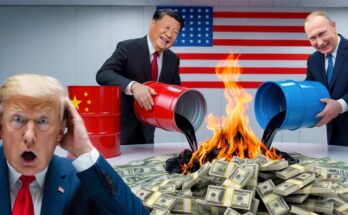The modern world runs on rare earth metals. These 17 elements, including Neodymium, Dysprosium, and Terbium, are not just obscure minerals; they are the unseen foundation of every smartphone, missile guidance system, electric motor, and wind turbine. Without them, the modern world—from military technology to green energy—would simply grind to a halt. The harsh truth is that China controls over 90% of the global refinement capacity and a significant majority of the mining, transforming these critical resources into a geopolitical weapon aimed squarely at the US and European economies.
The Rise of a Resource Monopoly
For years, Western nations, particularly the United States, underestimated this vulnerability. Lured by the promise of cheap Chinese production, they allowed Beijing to build a near-total monopoly, not just in mining but, crucially, in the industrial-grade refinement of these minerals. The focus on low-cost production led to a strategic complacency that is now resulting in widespread panic.
The full weight of this dominance became clear when China subtly imposed new restrictions on rare earth exports, citing “national security concerns.” This was a clear message: Do not test us.
The consequences were immediate. Automakers and aerospace companies found themselves struggling with delayed licenses, shrinking quotas, and zero transparency. Even the United States’ only major rare earth deposit, the Mountain Pass mine in California, must ship its output to China for processing because America lacks the necessary infrastructure. The dependency is absolute: the Pentagon’s F-35 fighter jets, precision missiles, and nearly all complex components rely on Chinese magnets and refined materials.
The Looming Industrial Collapse
The threat is no longer hypothetical. According to industry experts, the United States may have enough refined rare earth reserves left for only two to three months. After that, entire sectors face severe production shutdowns.
We saw a preview of this chaos with the microchip shortage in 2020. This new crisis threatens to be worse. Rare earth elements are used in everything from windshield wipers and steering systems to the core of the engine itself, affecting every vehicle, not just electric ones. Major manufacturers like Ford have already experienced plant stoppages—unofficially linked by insiders to these mineral shortages—and while some have received temporary six-month emergency import licenses, no long-term solution is in place.
Europe is equally vulnerable, importing around 98% of its rare earth elements from China. German auto giants like BMW and Volkswagen, heavily reliant on Neodymium magnets for their electric motors, will be hit hard. Even critical green projects, such as offshore wind turbines, are facing delays due to a shortage of necessary Chinese components. The tighter China squeezes, the more visible the West’s strategic vulnerability becomes.
The Race for Plan B: A Global Pushback
Recognizing the existential threat, a new global alliance is beginning to take shape, focused on building alternative supply chains. This is being treated as a “moon landing” mission, requiring billions in subsidies and tight international coordination.
- India’s Initiative: India has opened negotiations with five Central Asian countries (Kazakhstan, Kyrgyzstan, Tajikistan, Turkmenistan, and Uzbekistan) to jointly explore and develop rare earth deposits. This initiative aims to create a new resource corridor, using Central Asia’s largely untapped mineral potential to challenge Beijing’s monopoly. For India, which imports over 80% of its rare earth metals from China, this is an urgent strategic necessity.
- Australian Breakthrough: Australia, with its rich reserves, is transforming itself from a raw materials exporter into an industrial processing hub. Companies like Lynas Rare Earths have launched the first commercial-scale production of Dysprosium oxide outside of China in Malaysia. The Australian government is investing over A$1.6 billion to build processing centers and secure the domestic production of essential magnets. This development provides much-needed confidence to Western manufacturers that reliable processing is possible outside of China’s control.
Despite this progress, time is short. Building a complete, vertically integrated supply chain—from ore to finished magnets—will take years. Meanwhile, China continues to strengthen its resource access across Africa and deepen its manufacturing ties in Southeast Asia.
The world is just one decision away from a resource catastrophe. The urgent task is not just to find minerals, but to build the industrial infrastructure to process them before the trade war escalates into a full-blown industrial collapse.



